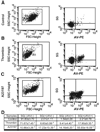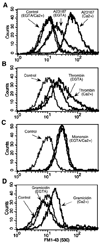Involvement of the Na+/H+ exchanger in membrane phosphatidylserine exposure during human platelet activation
- PMID: 16459134
- PMCID: PMC3118474
- DOI: 10.1016/j.bbalip.2005.12.008
Involvement of the Na+/H+ exchanger in membrane phosphatidylserine exposure during human platelet activation
Abstract
Platelet membrane phosphatidylserine (PS) exposure that regulates the production of thrombin represents an important link between platelet activation and the coagulation cascade. Here, we have evaluated the involvement of the Na+/H+ exchanger (NHE) in this process in human platelets. PS exposure induced in human platelets by thrombin, TRAP, collagen or TRAP+ collagen was abolished in a Na+ -free medium. Inhibition of the Na+/H+ exchanger (NHE) by 5-(N-Ethyl-N-Isopropyl) Amiloride (EIPA) reduced significantly PS exposure, whereas monensin or nigericin, which mimic or cause activation of NHE, respectively, reproduced the agonist effect. These data suggest a role for Na+ influx through NHE activation in the mechanism of PS exposure. This newly identified pathway does not discount a role for Ca2+, whose cytosolic concentration varies together with that of Na+ after agonist stimulation. Ca2+ deprivation from the incubation medium only attenuated PS exposure induced by thrombin, measured from the uptake of FM1-43 (a marker of phospholipid scrambling independent of external Ca2+). Surprisingly, removal of external Ca2+ partially reduced FM1-43 uptake induced by A23187, known as a Ca2+ ionophore. The residual effect can be attributed to an increase in [Na+]i mediated by the ionophore due to a lack of its specificity. Finally, phosphatidylinositol 4,5-bisphosphate (PIP2), previously reported as a target for Ca2+ in the induction of phospholipid scrambling, was involved in PS exposure through a regulation of NHE activity. All these results would indicate that the mechanism that results in PS exposure uses redundant pathways inextricably linked to the physio-pathological requirements of this process.
Figures




Similar articles
-
Involvement of Na+/H+ exchanger in desmopressin-induced platelet procoagulant response.Acta Biochim Pol. 2004;51(3):773-88. Acta Biochim Pol. 2004. PMID: 15448738
-
Regulation of intracellular pH in human platelets. Effects of thrombin, A23187, and ionomycin and evidence for activation of Na+/H+ exchange and its inhibition by amiloride analogs.J Biol Chem. 1986 Oct 5;261(28):13160-7. J Biol Chem. 1986. PMID: 3020026
-
Ca2+ mobilization can occur independent of acceleration of Na+/H+ exchange in thrombin-stimulated human platelets.J Biol Chem. 1988 Jul 15;263(20):9635-9. J Biol Chem. 1988. PMID: 2838474
-
The involvement of the Na(+)/H(+) exchanger in the formation of microvesicles by porcine platelets.Haematologia (Budap). 2002;32(3):239-52. doi: 10.1163/15685590260461057. Haematologia (Budap). 2002. PMID: 12611484
-
Vasopressin acts on platelets to generate procoagulant activity.Blood Coagul Fibrinolysis. 2008 Oct;19(7):615-24. doi: 10.1097/MBC.0b013e328309905d. Blood Coagul Fibrinolysis. 2008. PMID: 18832900
Cited by
-
Microparticles and cardiovascular diseases.Ann Med. 2019 May-Jun;51(3-4):193-223. doi: 10.1080/07853890.2019.1609076. Epub 2019 Jun 17. Ann Med. 2019. PMID: 31007084 Free PMC article. Review.
-
Mitochondrially mediated integrin αIIbβ3 protein inactivation limits thrombus growth.J Biol Chem. 2013 Oct 18;288(42):30672-30681. doi: 10.1074/jbc.M113.472688. Epub 2013 Sep 6. J Biol Chem. 2013. PMID: 24014035 Free PMC article.
-
The taming of a scramblase.J Gen Physiol. 2021 Apr 5;153(4):e202012831. doi: 10.1085/jgp.202012831. J Gen Physiol. 2021. PMID: 33661279 Free PMC article.
-
Study on the Mechanism of the Adrenaline-Evoked Procoagulant Response in Human Platelets.Int J Mol Sci. 2024 Mar 5;25(5):2997. doi: 10.3390/ijms25052997. Int J Mol Sci. 2024. PMID: 38474244 Free PMC article.
-
Na(+)/H(+) exchanger in the regulation of platelet activation and paradoxical effects of cariporide.Exp Neurol. 2015 Oct;272:11-6. doi: 10.1016/j.expneurol.2014.12.023. Epub 2015 Jan 13. Exp Neurol. 2015. PMID: 25595121 Free PMC article. Review.
References
-
- Devaux PF. Static and dynamic lipid asymmetry in cell membranes. Biochemistry. 1991;30:1163–1173. - PubMed
-
- Bevers EM, Comfurius P, Dekkers DW, Zwaal RF. Lipid translocation across the plasma membrane of mammalian cells. Biochim. Biophys. Acta. 1999;1439:317–330. - PubMed
-
- Majumder R, Weinreb G, Zhai X, Lentz BR. Soluble phosphatidylserine triggers assembly in solution of a prothrombin-activating complex in the absence of a membrane surfac. J. Biol. Chem. 2002;277:29765–29773. - PubMed
-
- Mann KG, Brummel K, Butenas S. What is all that thrombin for? J. Thromb. Haemost. 2003;1:1504–1514. - PubMed
-
- Lentz BR. Exposure of platelet membrane phosphatidylserine regulates blood coagulation. Prog. Lipid Res. 2003;42:423–438. - PubMed
Publication types
MeSH terms
Substances
Grants and funding
LinkOut - more resources
Full Text Sources
Miscellaneous

